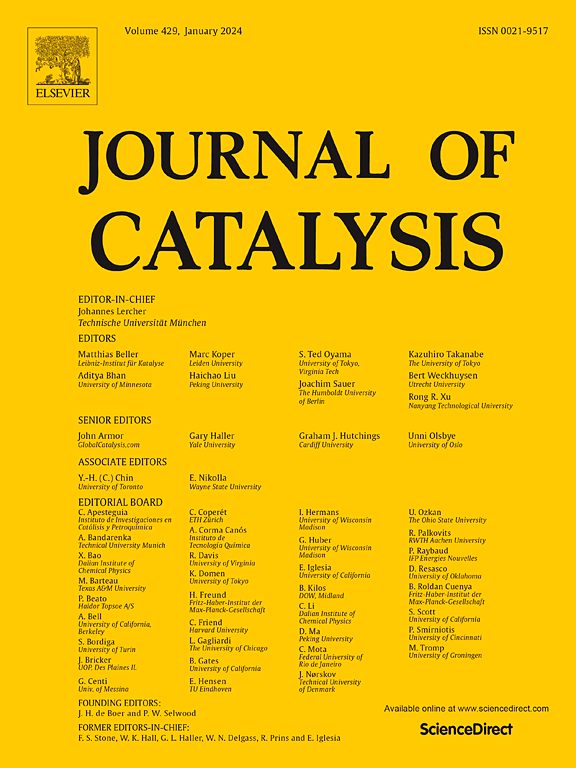一锅干球磨法制备碱金属掺杂Ru/MgO氨分解催化剂:K、Rb、Cs的结构和电子促进作用
IF 6.5
1区 化学
Q2 CHEMISTRY, PHYSICAL
引用次数: 0
摘要
氨分解是一种很有前途的燃料电池现场制氢方法。钌是该过程中最活跃的催化剂,其几何和电子性质的调制是实现高催化性能的必要条件。本研究开发了一种以醋酸盐为前驱体的一锅干球磨法合成碱金属掺杂Ru/MgO催化剂的简便方法。表征结果表明,K、Rb和Cs是有效的结构启动子和电子启动子。值得注意的是,碱金属的存在显著抑制了块状RuO2的聚集,导致形成分散良好的RuOx, RuOx在还原后产生小的Ru纳米颗粒。Ru的平均粒径约为2 ~ 3 nm,符合B5位最大化的理论最佳粒径。XAS和DRIFTS分析证实钌是稳定的,因为钌和碱金属之间通过氧键产生了强的金属-促进剂相互作用。所得碱金属促进的Ru纳米颗粒表现出优异的低温氨分解活性。2 K-3 %Ru/MgO催化剂在400 °C下,在30,000 mL gcat−1 h−1条件下,反应速率高达11.5 mmol-NH3 gcat−1 min−1,是Ru催化剂中性能最高的催化剂之一。此外,该催化剂在475 °C下保持高活性50 h,没有明显的失活。催化性能的增强是由于碱金属的结构和电子促进作用,促进了富B5位和富电子Ru纳米颗粒的形成。这些发现对碱金属的作用提供了有价值的见解,并为设计高效的碱金属促进钌催化剂提供了有益的指导。本文章由计算机程序翻译,如有差异,请以英文原文为准。


Facile preparation of alkali metal-doped Ru/MgO catalysts for ammonia decomposition via one-pot dry ball milling: structural and electronic promoting effect of K, Rb, and Cs
Ammonia decomposition is a promising method for on-site hydrogen generation for fuel cells. Ruthenium is the most active catalyst for this process, and modulation of its geometric and electronic properties is essential for achieving high catalytic performance. This study developed a facile approach for synthesizing alkali metal-doped Ru/MgO catalysts using a one-pot dry ball milling method with acetates as precursors. Characterization results indicate that K, Rb, and Cs act as effective structural and electronic promoters. Notably, the presence of alkali metals significantly inhibits the aggregation of bulk-like RuO2, leading to the formation of well-dispersed RuOx, which, upon reduction, produces small Ru nanoparticles. The average Ru particle size is about 2–3 nm, aligning with the theoretical optimal size for maximizing B5 sites. XAS and DRIFTS analyses confirm that Ru species are stabilized due to the strong metal-promoter interaction between ruthenium and alkali metals via oxygen bonding. The resulting alkali metal-promoted Ru nanoparticles exhibit superior low-temperature activity for ammonia decomposition. The 2 K-3 %Ru/MgO catalyst achieves a high reaction rate of 11.5 mmol-NH3 gcat−1 min−1 at 400 °C under 30,000 mL gcat−1 h−1, demonstrating one of the highest performances among Ru catalysts. Furthermore, this catalyst maintains high activity at 475 °C for 50 h without significant deactivation. The enhanced catalytic performance is attributed to the structural and electronic promotion effects of alkali metals, which facilitate the formation of B5 site-rich and electron-rich Ru nanoparticles. These findings offer valuable insights into the role of alkali metals and provide helpful guidance for designing efficient alkali metal-promoted ruthenium catalysts for practical applications.
求助全文
通过发布文献求助,成功后即可免费获取论文全文。
去求助
来源期刊

Journal of Catalysis
工程技术-工程:化工
CiteScore
12.30
自引率
5.50%
发文量
447
审稿时长
31 days
期刊介绍:
The Journal of Catalysis publishes scholarly articles on both heterogeneous and homogeneous catalysis, covering a wide range of chemical transformations. These include various types of catalysis, such as those mediated by photons, plasmons, and electrons. The focus of the studies is to understand the relationship between catalytic function and the underlying chemical properties of surfaces and metal complexes.
The articles in the journal offer innovative concepts and explore the synthesis and kinetics of inorganic solids and homogeneous complexes. Furthermore, they discuss spectroscopic techniques for characterizing catalysts, investigate the interaction of probes and reacting species with catalysts, and employ theoretical methods.
The research presented in the journal should have direct relevance to the field of catalytic processes, addressing either fundamental aspects or applications of catalysis.
 求助内容:
求助内容: 应助结果提醒方式:
应助结果提醒方式:


